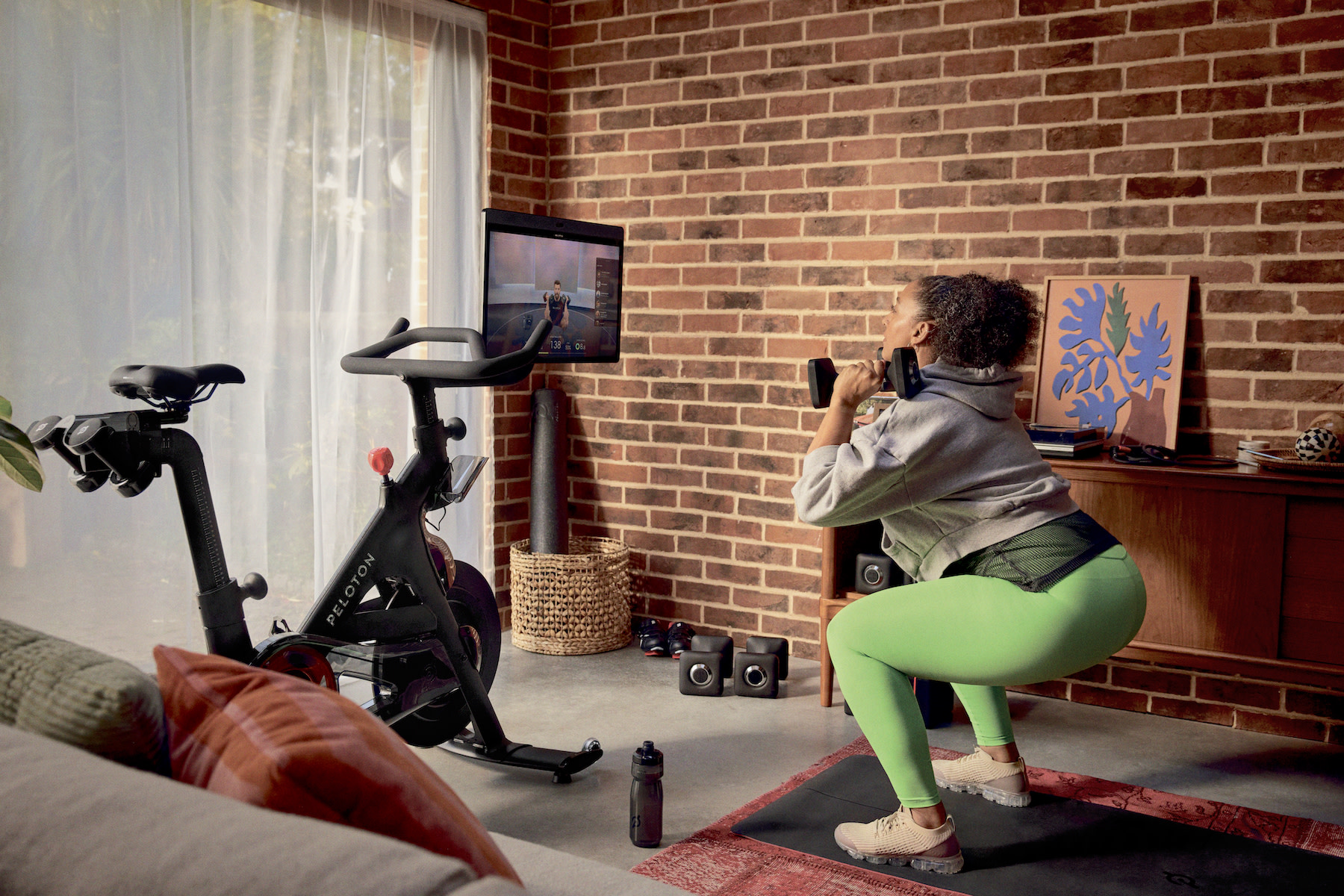
Should You Combine Cardio and Strength Training?
Is cardio or strength training better? You need both for the best results in your fitness routine.
By Team Peloton•
What Is Cardio?
What Are the Benefits of Cardio?
What Is Strength Training?
What Are the Benefits of Strength Training?
Cardio vs. Strength Training for Maintaining a Healthy Weight
How To Combine Cardio and Strength Training
When it comes to working out, we all have our preferences. Some are firmly in the cardio camp, while others are fans of free weights and resistance training. But in the cardio vs. strength training debate, one thing is clear. Just like PB&J, some things are better together. “The best workouts include a dose of strength and a dose of cardio,” agrees Peloton instructor Ben Alldis. “The benefits are reciprocal—not only does weight training strengthen your cycling and running (and vice versa), it also builds you up to tackle those functional, day-to-day movements.”
Each boasts major health and fitness benefits, so by bringing cardio and strength training together, you’re getting the best of both worlds and powering up your workouts.
Here, we dive into cardio vs. strength training for improved endurance and health benefits, and share why a cardio-strength pairing should be the cornerstone of your fitness routine.
What Is Cardio?
Cardio is any form of aerobic exercise that gets your heart pumping over a sustained amount of time. Short for cardiovascular training or conditioning, cardio works to increase your heart rate and breathing, boosting the flow of oxygen through your blood vessels to power your movement.
Running, swimming, cycling, rowing, and power walking are some of the most popular forms of cardio, but it can also include dance cardio, hiking, aerobics, and HIIT. Even walking up and down stairs on repeat can be considered cardio. As long as you’re moving at a moderate to fast pace, breathing faster, and working up a sweat—even a little one—you can consider it a form of cardio.
How Often Should You Do Cardio?
Medical professionals recommend doing at least 150 minutes of moderate intensity exercise per week. That could be broken down into 30 minutes five times a week or even shorter bursts of 10 to 15 minutes several times a day depending on your schedule and workout preferences. The most important thing is finding a form of cardio (or multiple) that feels right for your body and goals, and, crucially, that you’ll stick with.

Peloton App
Access thousands of classes with no equipment needed.
What Are the Benefits of Cardio?
Cardio truly boasts a multitude of benefits, ranging from improved fitness levels to better physical and mental health. “Cardio exercise helps improve your body’s ability to deliver blood and oxygen to your muscles, strengthening your heart and lungs,” says Ben. Here are just a few of its core benefits.
1. Cardio Keeps Your Heart Healthy
Boosting your heart rate with regular cardio has been shown to improve general cardiovascular health, helping to prevent heart disease and other non-cardiovascular diseases such as diabetes, osteoporosis, and even colon cancer.
2. Cardio Boosts Your Immune System
Cardio can help you fight off sickness, with even small amounts aiding your immune system. A 2009 study on 13 young males found that 20-minute bouts of cardio, varying in intensity from low to high intensity, all helped activate the immune system by increasing the amount of white blood cells in the body. While the low-intensity exercises were beneficial, higher intensity cardio had an even stronger effect on the participants’ immune cells.
3. Cardio Boosts Your Mood and Energy Levels
That buzz you get when you’ve worked out? That’ll be your endorphins kicking in. Cardio boosts the production of endorphins, with studies showing it helps to lift your mood and improve your overall mental health.

What Is Strength Training?
Strength training is also known as weight training, lifting, or resistance training, and is any form of exercise that uses resistance to build strength. That resistance causes contracting in your muscles, which over time builds more strength and endurance, and thus grows more muscle.
The weight or resistance can be from free weights, such as kettlebells or dumbbells, a weight machine, resistance bands, or even your own body weight.
Unlike cardio, which is aerobic exercise, strength training is typically anaerobic exercise, which means it doesn’t use oxygen for energy, instead breaking down the glucose in your body. There can be crossover between cardio and strength training. For example, if you do a particularly vigorous strength workout that gets your heart rate up, this can fall into the cardio category too, as your body will also be using oxygen for energy. HIIT can be a great hybrid workout, depending on the exercises you do and the duration.
What Are the Benefits of Strength Training?
Like cardio, strength training has lots of benefits for your mind and body. “Strength training helps you build muscles that support you in your everyday life and boosts your metabolism,” shares Ben. Here are three key reasons you need strength training as part of your routine.
1. Strength Training Builds Muscle
Building and sculpting muscle is the signature goal of strength training. Through a process known as hypertrophy, with regular strength training, new muscle cells are grown over time, replacing fat. Since muscle tissue is considered more metabolically active than fat(meaning it needs more fuel to power it),increased muscle mass means you burn more calories over time. Building muscle helps boost your resting metabolism too, so you’ll keep burning those calories even after you’ve finished working out.
2. Strength Training Improves Bone Health
Any form of strength or resistance training can help promote better bone health and improve bone density. Stronger bones mean protection against injuries and a lower likelihood of developing osteoporosis or osteopenia. A recent study showed that as little as 15 to 20 minutes of weight training exercises, three days a week, can improve bone density.
3. Strength Training Provides Stress Relief and Can Boost Mental Health
Just like cardio releases endorphins and endocannabinoids to make you feel good post-workout, strength training has been found to improve mental health too. In addition to helping decrease symptoms of depression and anxiety, it can boost confidence and improve the mind-body connection.
Cardio vs. Strength Training for Maintaining a Healthy Weight
Both cardio and strength training have the capability to help you burn calories, boost your metabolism, and maintain a healthy weight, but they do it in different ways.
Cardio helps you burn calories and, at certain intensities, fat stores, while you work out.
While cardio may burn calories faster than strength training, it only does this during your workout. Strength training plays the long game, building muscle mass over time, boosting your metabolism, and burning calories even when you’re not in workout mode.
The truth is, both cardio and strength training are required to maintain a healthy weight—and for your overall health. Depending on your fitness goals, combining cardio and strength workouts can really help you harness all the benefits. “It taps into all the ways your body can output power, including improved overall cardio capacity, learning how to work hard under fatigue, increasing your fitness level and building strength via a full-body experience,” says Peloton instructor Rebecca Kennedy, who is passionate about strength training with both dumbbells and bodyweight.

How To Combine Cardio and Strength Training
“A healthy combination of strength and cardio training will allow your body to perform at its best, letting the two systems complement each other rather than compete,” says Ben.
Rebecca agrees. “Combining cardio, like running, with strength will change your life,” she says. “After your first run, you'll be introduced to an entire world that is home to more growth, new challenges, a higher level of fitness, and a new place to succeed and learn in.”
If you’re thinking this all sounds great, but are wondering where to start and how to plan out your cardio and strength training workouts, this is where a structured bootcamp-style program (like those offered on the Peloton App) can help by taking the stress out of planning. “It’s an incredibly effective workout and efficient use of time,” Rebecca says. “These intense workouts bring the best of worlds into one workout that will make you stronger and leave you incredibly sweaty, feeling confident and proud.”
In a bootcamp you may focus on unilateral drills, do exercises that target the posterior chain or back of the body on the floor specifically to enhance your running, or do squats and anterior core exercises to complement some hills. “Plus, you’ll keep your heart rate elevated and adrenaline pumping with quick switches between your exercise bike or treadmill and your mat,” Rebecca says. “And before you know it, it’ll be over and you’ll be left planning when you can do it all over again.”
If a bootcamp doesn’t appeal, there are other options.
HIIT (High Intensity Interval Training) workouts offer the best of both worlds and are so effective that research has found that just two weeks of HIIT is as effective as six to eight weeks of endurance training.
Integrate your preferred exercise of the two with five to 10 minutes of the other. Have some workout sessions that are more cardio-based and others that are more strength training-focused.
Focus on strength training a different muscle group each session. Cycle through legs and butt, core, and arms and shoulders, then repeat the cycle.
For your cardio, schedule a mix of low-, moderate-, and high-intensity cardio into your week.
Cardio or Strength Training First?
If you’re looking to course out your training, this will be a question that comes up for you. As hotly debated as the chicken or the egg, the order of cardio or strength training really depends on your fitness goals. For example, if you want to burn more calories and fat, do weights first followed by cardio, and the same goes if you’re looking to build strength. If you want to improve your endurance for, say, a race, start with cardio and end with weights.
If you’re doing an upper-body strength training session, you can start with either, while for lower-body strength training, try doing weights first, then cardio. The main thing is to make sure you keep things balanced and don’t overtrain. Ease into your new schedule and build it up as you go. Make sure you schedule in rest days, too.
If you have any injuries or health issues, always consult your physician before starting any new routines. Balance your workouts with plenty of stretching and warmups and cool-downs.

Peloton App
Access thousands of classes with no equipment needed.
This content is for informational and educational purposes only and does not constitute individualized advice. It is not intended to replace professional medical evaluation, diagnosis, or treatment. Seek the advice of your physician for questions you may have regarding your health or a medical condition. If you are having a medical emergency, call your physician or 911 immediately.
Level up your inbox.
Subscribe for a weekly dose of fitness, plus the latest promos, launches, and events.
By providing your email address, you agree to receive marketing communications from Peloton.
For more about how we use your information, see our Privacy Policy.









